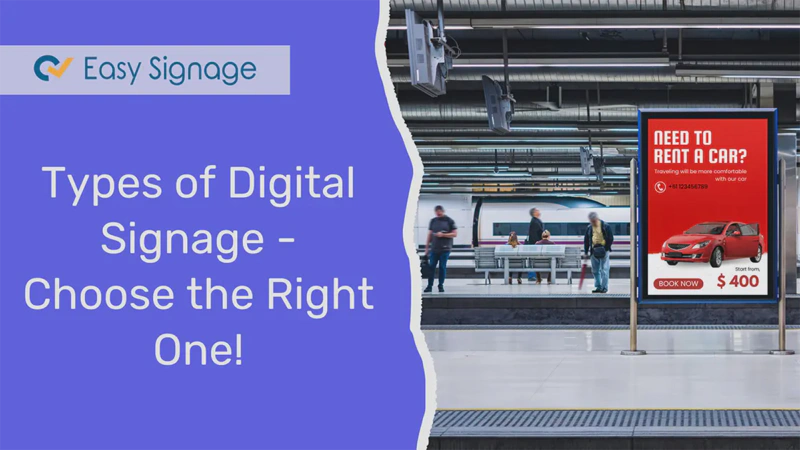Types of Digital Signage - Choose the Right One!

Digital signage has revolutionized the way businesses can communicate with their audience. Gone are the days of boring and static traditional displays - technology is constantly advancing, and signs can now be dynamic and interactive, engaging with customers and conveying information much more interestingly.
But how your display works will also depend greatly on the type of digital signage you use. So what are your options, and what kind of digital signage should you choose for your business? Let’s take a look.
Indoor Digital Signage

The first differentiating factor between the types of signage is whether it’s meant to be used indoors or outdoors. Indoor signage performs a different function and is usually used for displaying content within spaces like lobbies, waiting rooms, or retail stores.
Besides advertisements, indoor signage is also often used in corporate settings to give reminders about upcoming events or meetings. Some also use it to give employees motivation and recognition.
Regardless of what they’re used for, indoor signage options differ greatly from outdoor ones.
1. Digital Displays
Digital displays are a popular type of indoor signage and are used for displaying images, videos, or text on electronic screens. These are usually mounted on walls or stands to make them more visible to everyone in the area.
Digital displays are very flexible regarding what kind of content you want to show at specific times of the day. Some more complex options may even be responsive to triggers like weather or foot traffic. Such features are useful for businesses since they can tailor their messaging depending on the available audience.
Digital displays are also used for the purpose of announcements, news updates, and information like menus and deals in restaurants and stores. With all their different types of usage, they are versatile and effective at capturing attention and engaging audiences.
2. Interactive Displays
Interactive displays are similar to digital displays, except they involve a further level of engagement by allowing the audience to interact with the content being displayed using touch sensors. In fact, the difference between the two in terms of technology is usually just that digital displays use non-touch screens, while interactive ones use touchscreens.
Interactive displays are particularly useful for engaging audiences in educational or informational contexts since they allow for an easier and more interesting way for the consumer to interact with the content being displayed.
Interactive displays are also better for displaying more targeted and relevant content. For example, by incorporating interactive features, audiences can head over to the information they need by selecting options that narrow their search requirements.
They are also a great way for businesses to set up quizzes, polls, or surveys to collect feedback from new people.
Just like digital displays, interactive displays are very flexible and can be programmed to display different content depending on the available audience.
3. Kiosks
Kiosks are very similar to interactive displays, except these are more about the individual experience rather than everyone available. They are typically standalone units with an interactive touchscreen and other types of technology that lets customers interact with the content.
Think ATMs, digital menus, and self-checkout counters, where the content prompts and gives information on how to go forward.
Kiosks are great for giving users a self-service option and are quite useful for generating revenue for businesses, but they aren’t all that great for digital advertisements or announcements. Though these things can still be incorporated into the kiosk display, the audience it reaches will be very limited in comparison to other types of signage.
Still, the purpose of kiosks is not usually to make announcements or advertisements but to collect information from customers, and they are very reliable on that front.
4. Video Wall
Digital displays are great, but they can lose some of their charms once you start seeing them everywhere. In fact, you’ve probably seen digital displays that start blurring into the background now, just like static displays.
Video walls take that a step further by using multiple display screens arranged in a grid to create one large display. These are usually used in retail spaces, airports, or stadiums and effectively capture attention.
For one thing, because they are so large, it’s difficult to miss them, but they can also make the display much more dynamic than a single display could.
Besides the obvious application of video walls for advertisements and such, they are also pretty great for enhancing the ambiance of an indoor space. Because the display is likely bright and vibrant, they are great for making the environment more immersive.
Just like regular display screens, video walls can also be programmed to show different types of content depending on the audience, making them very flexible and versatile.
Outdoor Digital Signage

Outdoor signage is very different from indoor signage in terms of who it addresses, what kind of signs are used, and the audience itself. They are usually meant for advertisements and reach a much larger audience than indoor signs, where the audience is limited to the people likely to pass by the specific space.
Outdoor digital signage is also made to be sturdier and built to withstand different weather conditions like rain, snow, and extreme temperatures. The same items used in indoor signage will probably not be able to stand their ground in such circumstances.
1. Digital Billboards
Digital billboards are very common as a form of outdoor signage and are used for much the same reasons as regular billboards - but with a more dynamic visual appeal. Digital billboards are usually placed in high-traffic areas and made to capture attention.
They’re easy to update and adjust, which makes them a lot more convenient than regular billboards, and they are also much more eco-friendly. At the same time, it’s important that digital billboards not be made to distract drivers.
Digital billboards can display full-motion video, animation, and other types of content.
2. LED Displays
LED displays, as the name suggests, use LEDs to display the content on the screen. They are a great option for outdoor signs since their brightness makes them visible even in sunlight. As a result, they are very effective and can easily capture attention.
LED displays are also very good at delivering targeted messages to specific audiences because they can be programmed to display specific types of content depending on the audience. They can be used in a way similar to indoor digital displays - except for the outdoors.
They can also be used much like digital displays for video walls, where multiple displays are put together to create a larger one. They are energy-efficient and eco-friendly, so many businesses are turning to LED displays for their digital signage.
3. Mobile Displays
Another form of outdoor signage that has gained popularity in recent years is mobile displays. Many businesses and organizations are looking for new and innovative ways to reach their audience, and what better way to do that than to deliver the message to their doorstep?
Well, mobile displays don’t go to your doorstep, but they do come close! Digital trucks, carts, and trailers are now being made with high-quality digital displays that cover the space where static advertisements and announcements used to be added.
Therefore, they can carry the digital display around as they drive through the streets, reaching a much larger and more diverse audience than if the same display was in one place the whole time.
This can be specifically helpful for promoting products and events that are largely time-bound and can create hype around them. After all, a moving display that quickly runs out of sight will capture your attention a lot more than a billboard that you are passing by. Because of the limited time you get to see it, it also creates excitement and urgency that other types of outdoor signage may not be able to.
Mobile displays are also very customizable because they come in different sizes and configurations, and the content on them can be adjusted depending on the time and location. Most carts or trailers carrying the signs are usually designed and branded to reflect the business they are advertising on the signs as well, which adds to the experience.
Mobile signage does involve some very careful planning in terms of route, driver training, and maintenance, though, so it can quickly become very costly.
Conclusion
Regardless of what type of signs you use, digital signage will prove to be an effective tool for reaching customers with your offering and marketing messages. Knowing the pros and cons of these types will help you decide which is best suited for your business.
Still, it’s important to keep in mind that the type of signage you use doesn’t matter as much as the content you display on it. Make sure to use engaging and informative content that resonates with the audience, and the type of digital signage you opt for will definitely bring your business success.
Implementing digital signage doesn’t involve as much effort as it looks on the surface. All you need to start is the right hardware and EasySignage. Take advantage of all the benefits of digital signage, and sign up with us!